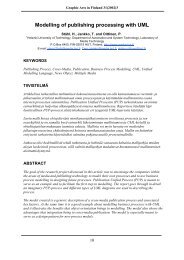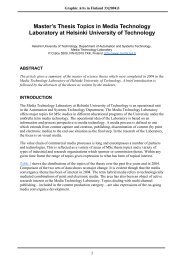Client-Side Storage in Web Applications
Client-Side Storage in Web Applications
Client-Side Storage in Web Applications
You also want an ePaper? Increase the reach of your titles
YUMPU automatically turns print PDFs into web optimized ePapers that Google loves.
4 Related Research ProjectsThis section presents research projects that <strong>in</strong> one way or another utilize recent client-sidestorage mechanisms. The focus is laid especially on two research projects,Sync Kit [5] and Silo [18], but other related research projects are also briefly covered.4.1 Sync KitSync Kit [5] is a client/server toolkit for improv<strong>in</strong>g the performance of data<strong>in</strong>tensivewebsites. Sync Kit uses JavaScript and (Google) Gears on the client side,mean<strong>in</strong>g the approach requires the <strong>in</strong>stallation of the Gears plug-<strong>in</strong> <strong>in</strong> order to work.Gears could be, however, replaced with a W3C-specified client-side storage mechanismto get rid of the requirement. On the server side, a Sync Kit aware web server isrequired. In their case, Sync Kit was implemented as a collection of scripts for theDjango 10 web framework.The idea beh<strong>in</strong>d Sync Kit is to use Gears to store (cache) web page templates onthe client side. Templates <strong>in</strong>clude a JavaScript library and data endpo<strong>in</strong>t def<strong>in</strong>itions toaccess dynamic contents resid<strong>in</strong>g on the server. Data endpo<strong>in</strong>ts, on the other hand,cache database objects to Gears and keep the cached data consistent with the backenddatabase. When a browser requests a web page for the first time, the template is returnedas a response and stored <strong>in</strong> the client-side storage. Then, new data is requestedvia template’s data endpo<strong>in</strong>ts. F<strong>in</strong>ally, the retrieved data is added to the template,cached on the client-side storage, and the result is displayed to the user.Accord<strong>in</strong>g to Benson et al. [5], their solution reduces server load by a factor offour and data transfer up to 5% compared to the traditional approach, when cache hitrates are high.4.2 SiloSilo [18] is a framework for deploy<strong>in</strong>g fast-load<strong>in</strong>g web applications. Silo usesJavaScript and <strong>Web</strong> <strong>Storage</strong> on the client side (both standard web technologies),mean<strong>in</strong>g the approach works on all modern web browsers. On the server side, a Siloawareweb server is required.The idea beh<strong>in</strong>d Silo is to use <strong>Web</strong> <strong>Storage</strong> to store (cache) website’s JavaScriptand CSS chunks (2 kB <strong>in</strong> size) on the client side. When a browser requests a webpage, the server returns a modified version of the web page conta<strong>in</strong><strong>in</strong>g a smallJavaScript shim with a list of required chunk ids. Next, the shim checks the client-sidestorage for available chunks and <strong>in</strong>forms the server of the miss<strong>in</strong>g chunks us<strong>in</strong>g theirids. Then, the server replies with the raw data for the miss<strong>in</strong>g chunks. F<strong>in</strong>ally, the webpage is reconstructed <strong>in</strong>to its orig<strong>in</strong>al form on the client us<strong>in</strong>g the JavaScript shim.Moreover, the second HTTP round trip can be completely elim<strong>in</strong>ated by utiliz<strong>in</strong>gHTTP cookies <strong>in</strong> the <strong>in</strong>itial HTTP request for send<strong>in</strong>g the already available chunk ids.10 Django, https://www.djangoproject.com/12
















